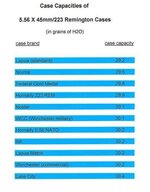- Messages
- 802
- Reactions
- 325
I got some dies, powder (BL-C(2)), primers, and 65 gr Sierra GameKings. I've found reloading data that applies but it is all for .223 Rem chambers and pressures. Has anybody here tried a load for the higher 5.56 pressure rating? Might be able to get a few more FPS out of my fairly short AR.
Bryan
Bryan












